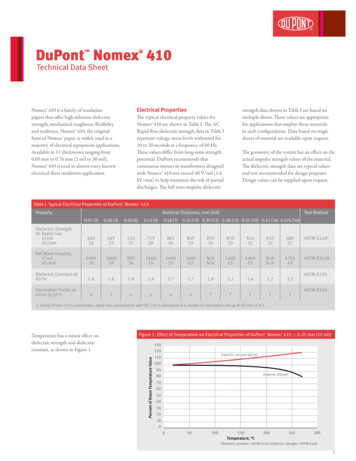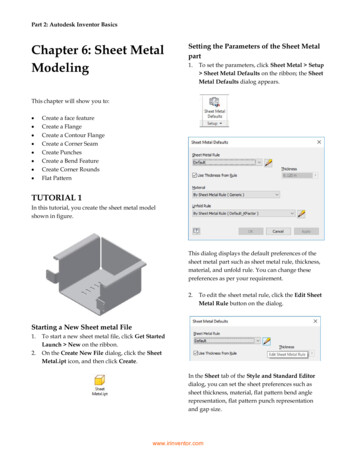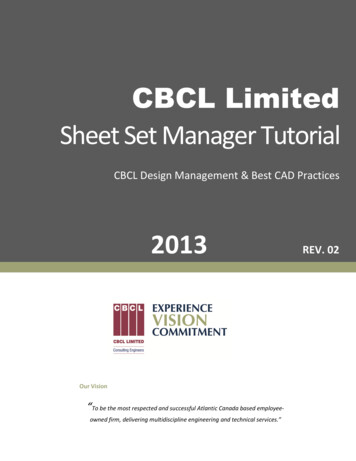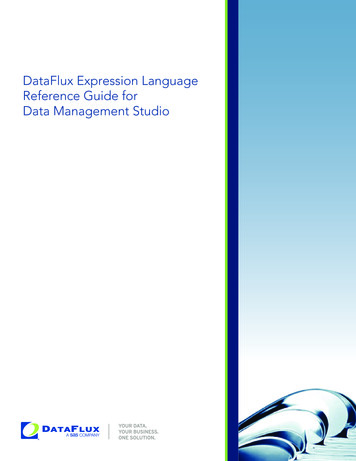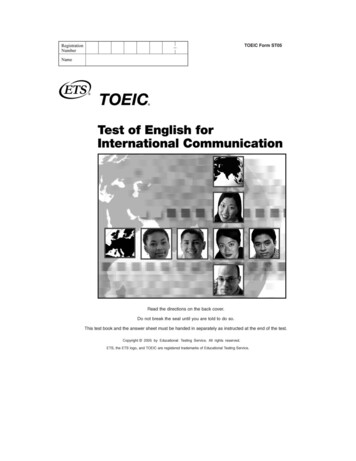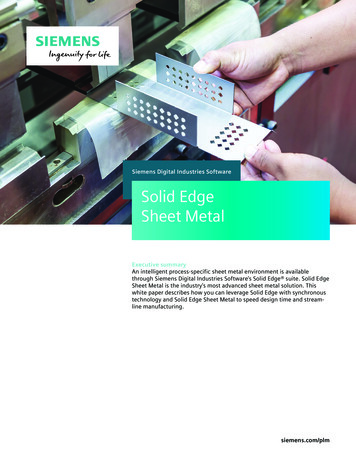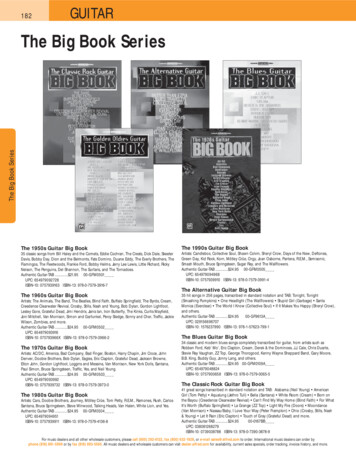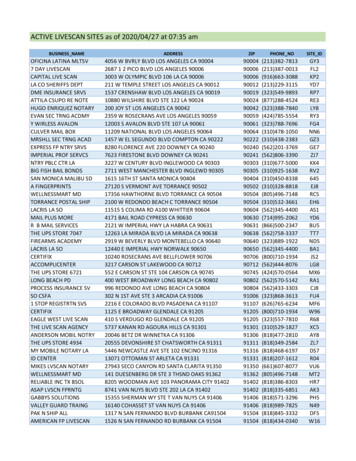
Transcription
DuPont Nomex 818 Technical Data SheetNomex 818 is designed for high-voltageapplications, including motor conductor andcoil wrap, transformer ground and layerinsulation. It is a calendered product with highinherent dielectric strength (700 V/mil to1,000 V/mil [30 kV/mm to 40 kV/mm]),which can be readily impregnated withvarnishes where this is desirable. Nomex 818is available in five thicknesses, ranging from0.08 mm to 0.25 mm (3 mil to 10 mil). Thiscalendered blend of aramid and mica offersincreased voltage endurance compared toNomex 410 when subjected to corona attack.of materials previously designated as Nomex 418 should know that these are the identicalmaterials to those now designated as Nomex 818. Materials formerly designated as Nomex 419 are no longer sold commercially. The 800Series of mica-containing products includesnew materials designated as Nomex 864.These materials are sold only for laminatingwith other sheets or films, and the properties ofthe laminated sheets are dependent on the finalcombinations of sheet materials. Therefore, theindividual mechanical and electrical propertiesfor Nomex 864 products are not listed here.The AC Rapid Rise dielectric strength datain Table I represent voltage stress levelswithstood for 10 to 20 seconds at a frequencyof 60 Hz. These values differ from long-termstrength potential. DuPont recommends thatcontinuous stresses in transformers designedwith Nomex 818 not exceed 80 V/mil(3.2 kV/mm) to minimize the risk of partialdischarges. The full wave impulse dielectricstrength data in Table I were generated on flatsheets, such as in layer and barrier applications.The geometry of the system has an effect on theactual impulse strength values of the material.Periodically, DuPont upgrades the branding ofits materials to reflect a more consistent familyof products for similar applications. CustomersElectrical PropertiesThe dielectric strength data are typical valuesand not recommended for design purposes.Design values can be supplied upon request.The typical electrical property values forNomex 818 papers are shown in Table I.Table I. Typical Electrical Properties of DuPont Nomex 818 PropertyNominal Thickness, mm (mil)Test Method0.08 (3)0.13 (5)0.15 (6)0.20 (8)0.25 (10)Dielectric Strength AC Rapid 0ASTM D149¹Full Wave TM D3426Dielectric Constant at 60 Hz50% RHDry²2.92.33.62.55.03.04.02.54.12.5ASTM D150Dissipation Factor at 60 Hz (x10-³)50% RHDry²13061206180514061406ASTM D150Volume Resistivity, ohm.cm50% M D257Surface Resistivity, ohm/square50% M D2571. Using 50-mm (2-in.) electrodes, rapid rise; corresponds with IEC 243-1 subclause 9.1, except for electrodes set-up of 50 mm (2 in.).2. Values measured at 23 C after one hour drying at 120 C.1
Figure 1. Dissipation Factor versus Temperature and Frequency of DuPont Nomex 818 —0.13 mm (5 mil) 0.050.04Dissipation FactorThe effects of temperature on dielectricstrength and dielectric constant are shownfor Nomex 410 paper in Figure 1 of theNomex 410 technical data sheet. BecauseNomex 818 is composed 50% of inorganicmica, its properties are even more stablewith temperature. Dielectric constants ofNomex 818 papers are essentially unchangedover the range of 23 C to 250 C. The effects oftemperature and frequency on the dissipationfactor of dry Nomex 818—0.13 mm (5 mil)paper are shown in Figure 1.60 Hz0.03210 Hz0.02310 Hz0.01410 Hz0.000150Temperature, C 1017101610151014200250ASTM D150101310121011 Surface resistivityVolume resistivity050100150Temperature, C200250ASTM D257Figure 3. Voltage Endurance of Various Insulating Materials — Single-Layer 0.25 mm (10 mil)242016Stress in kV/mmLike other organic insulating materials,Nomex paper is gradually eroded under attackby corona discharges. However, Nomex 818is specifically designed to provide voltageendurance (long times to failure under coronaattack) at least equivalent to the best inorganicinsulations, and greatly superior to otherorganic materials, as shown in Figure 3.These data were obtained at 360 Hz frequency;times to failure at 50-60 Hz are approximately6 to 7 times as long as those indicated. Dueto its superior corona resistance, Nomex 818paper has been used commercially for manyyears to insulate stator coils in AC motors upto 13.6 kV class.100Figure 2. Resistivity versus Temperature of DuPont Nomex 818 — 0.13 mm (5 mil)Volume Resistivity, ohm.cm orSurface Resistivity, ohm/squareSurface and volume resistivities of dryNomex 818—0.13 mm (5 mil) paper areshown in Figure 2 as functions of temperature.Corresponding values for other thicknesses arevery similar.50Nomex 818 Paper128Glass/Mica splittings/Glass(with silicone)Polyester(mat/film/mat)–100% epoxyimpregnationPolyester FilmNomex 410 Paper4010 010 110 2Time for 5th of 10 Failures (hours)10 3This data is provided for comparative purposes only and should not be used as design values.104ASTM D2275 360 Hz2
Mechanical PropertiesWater is a plasticizing agent for Nomex 818paper. Dipping or soaking Nomex 818 papersin water reduces their tensile strengths to 30%to 50% of the typical values shown in Table II,but also increases break elongation by about3 times and makes the paper softer and moreconformable. This effect can be used toadvantage in some applications (similar to theThe typical mechanical property values forNomex 818 papers are shown in Table II.Nomex 818 paper retains at least 50% ofits room-temperature tensile strength andelongation at temperatures up to 250 C,as shown in Figure 4.common practice of dipping mica compositetapes in mixtures of water and alcohol toimprove their handling characteristics duringwrapping of motor coils). Due to the permeablenature of Nomex 818 paper, absorbed watercan be readily removed during normal dryingor baking procedures. This restores the paperproperties to their normal values.Table II. Typical Mechanical Properties of DuPont Nomex 818 PropertyNominal Thickness, mm (mil)Test Method0.08 (3)0.13 (5)0.15 (6)0.20 (8)0.25 (10)Typical 6ASTM D374¹Basis Weight, g/m²89.2148.4179.5240298ASTM D646Density, g/cc1.131.131.181.151.12Tensile Strength, N/cmMDXD312252386748916511178ASTM D828Elongation, %MDXD2.93.03.03.43.63.73.73.73.83.8ASTM D828Elmendorf Tear, NMDXD1.11.62.02.92.63.93.65.24.96.7TAPPI 414Initial Tear Strength, NMDXD961610201428193424ASTM D1004²Shrinkage at 300 C, %MDXD0.10.00.10.00.00.00.00.00.00.0MD Machine Direction; XD Cross Direction1. Method D, using 17 N/cm² for Nomex 818.2. D ata presented for initial tear strength is listed in the direction of the sample per ASTM D1004. The tear is 90 degrees to sample direction; hence, for paperswith a higher reported machine direction initial tear strength, the paper will be tougher to tear in the cross direction. Figure 4. Temperature Effects on Mechanical Properties of DuPont Nomex 818 — 0.13 mm (5 mil) Percent of Room Temperature Value120100Tensile strength (MD)8060Tensile elongation (MD)40200050100150Temperature, C200250300ASTM D8283
Arrhenius plots of thermal aging behavior forNomex are exemplified by Figures 7 and 8in the Nomex 410 technical data sheet.Similar aging of Nomex 818 papers at elevatedtemperatures has resulted in their recognitionas 220 C insulating materials.The thermal conductivity of Nomex 818—0.25 mm (10 mil) paper is shown in Figure 5as a function of temperature. The total systemconstruction may affect the overall thermalconductivity; therefore, care should be takenin applying individual sheet data to actualsituations. For example, two sheet insulationswith identical thermal conductivities may havequite different effects on heat transfer from acoil due to differences in stiffness or windingtension (which affect the spacing betweenthe insulation layers) or differences in theabsorption of impregnating varnishes.Figure 5. Thermal Conductivity versus Temperature for DuPont Nomex 818 – 0.25 mm (10 mil) 12010080604020050100150Temperature, C200250ASTM E1530Figure 6. Limiting Oxygen Index (LOI) of DuPont Nomex 818 – 0.13 mm (5 mil) 7565Limiting Oxygen Index, %Chemical StabilityThe compatibility of Nomex papers andpressboards with virtually all classes ofelectrical varnishes and adhesives (polyimides,silicones, epoxies, polyesters, acrylics,phenolics, synthetic rubbers, etc.), as wellas with other components of electricalequipment, is demonstrated by the manyUL-recognized systems comprising Nomex , aswell as long-standing commercial experience.Nomex 818 papers are specifically includedin these systems. These papers are also fullycompatible with transformer fluids (mineraland silicone oils and other synthetics) andwith lubricating oils and refrigerants used inhermetic systems. 140Thermal Conductivity, mWatt/meter KThermal Properties55453525150100200300400500Temperature, C600700800ASTM D2863The Limiting Oxygen Index (LOI) ofNomex 818—0.13 mm (5 mil) paper atroom temperature is 63%, declining to 52%at 220 C. Thicker grades should have slightlyhigher LOI. Materials with LOI above 20.8%will not support combustion in air. As isshown in Figure 6, Nomex 818 must be heatedto more than 700 C before its LOI declinesbelow the flammability threshold.4
Radiation ResistanceThis outstanding radiation resistance isanother indication of the basic chemicalstability of Nomex paper.polyester film and polyester mat of the samethickness, 100% epoxy-impregnated, crumblesafter 8 Mgy [800 megarads]). Similar resultswere obtained on exposure to gamma radiation.The effect of 64 Mgy (6400 megarads) of2 MeV beta radiation on the mechanical andelectrical properties of Nomex 818 is shownin Table III. (By comparison, a laminate ofTable III. Radiation Resistance of DuPont Nomex 818—0.25 mm (10 mil) to 2 MeV Electrons (Beta Rays) Dose, MgyPropertyTest Method01248163264Tensile Strength, % of 8ASTM D828Elongation, % of TM D828Dielectric 35053142056132052ASTM D149¹Dielectric Constantat 60 Hzat 1 Hzat 10 3.02.72.52.32.12.92.72.6ASTM D150Dissipation Factor (x 10-³)at 60 Hzat 1 Hzat 10 1ASTM D150MD Machine Direction; XD Cross Direction1. With a 6.4-mm (1.4-in.) electrode.UL RatingsTable IV shows the UL ratings for Nomex 818and Nomex 864 papers. Descriptions of thenumerical values for each of the UL ratingsare detailed in the UL website on ComponentMaterials, which can be accessed atiq.ul.com/ul/cert.aspx?ULID 230941TABLE IV. UL Ratings for DuPont Nomex 818 and Nomex 864 ASTM D374Thickness,mmASTM D374Thickness,milUL 94FlameClassUL 746AHWIRatingUL 746AHAIRatingUL 746BRTI ElectricalRatingUL 746BRTI MechanicalRatingUL 746AHVTRRatingUL 20335
For more information about DuPont Nomex or forglobal product support, contact us in your region: USA & Canada 1-800-931-3456nomexpaper.dupont.com/contactJapan Latin America 01-800-849-7514nomex.dupont.com.mx/contactGreater China 86-400-8851-888nomex.com/paper/cn/contactBrazil 0800-17-17-15nomex.dupont.com.br/contactIndia 91 1800-419-0899nomexpaper.dupont.co.in/contactUnited Kingdom es.nomex.co.uk/contactKorea 82 2-2222-5220Germany es.nomex.de/kontaktSingapore 65 6586-3688Thailand 662 659-4000nomexpaper.dupont.comThe properties in this data sheet are average values and should not be used as specification limits. Unless otherwise noted, allproperties were measured in air under “standard” conditions (in equilibrium at 23 C, 50% relative humidity). Note that, like otherproducts of papermaking technology, Nomex papers have somewhat different properties in the papermaking machine direction(MD) compared to the cross direction (XD). In some applications it may be necessary to orient the paper in the optimum directionto obtain its maximum potential performance. Product safety information is available upon request. This information corresponds to our current knowledge on the subject.It is offered solely to provide possible suggestions for your own experimentations. It is not intended, however, to substitutefor any testing you may need to conduct to determine for yourself the suitability of our products for your particular purposes.This information may be subject to revision as new knowledge and experience become available. Since we cannot anticipateall variations in actual end-use conditions, DUPONT MAKES NO WARRANTIES AND ASSUMES NO LIABILITY WHATSOEVER INCONNECTION WITH ANY USE OF THIS INFORMATION. Nothing in this publication is to be considered as a license to operateunder or a recommendation to infringe upon any trademark or patent right. Copyright 2016 DuPont. All rights reserved. The DuPont Oval Logo, DuPont and Nomex are trademarks or registeredtrademarks of E.I. du Pont de Nemours and Company or its affiliates. UL is a registered trademark of UL LLC. K-29356 (04/16) 6
Nomex 818 is composed 50% of inorganic mica, its properties are even more stable with temperature. Dielectric constants of Nomex 818 papers are essentially unchanged over the range of 23 C to 250 C. The effects of temperature and frequency on the dissipation factor of dry Nomex 818—0.13 mm (5 mil) paper are shown in Figure 1.
